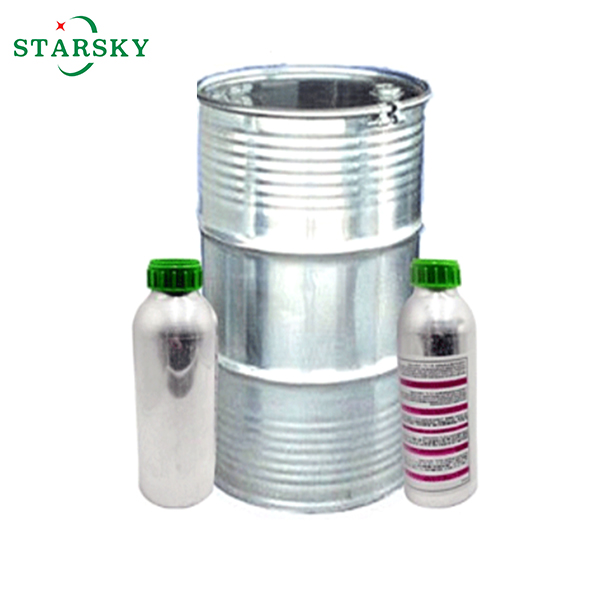There are 20000 bottles Desmodur RE in stock. We can ship the goods immediately after get order.
If you need, welcome to contact us at any time, More quantity with more discount. Don't miss it.
Phone: + 86 13162192651
Email: alia@starskychemcial.com
Description:
| Name | Triphenylmethane-4,4',4''-triisocyanate |
| Molecular Formula | C22H13N3O3 |
| CAS | 2422-91-5 |
| M.W | 367.36 |
| Character | manufacturer |
| Assay of NCO | 9.3±0.2% |
| Assay of methane | 27±1 |
| Viscosity ( 20℃) | 3 mPa.s |
| Solvent | Ethyl acetate |
| Density | 1.0g/c m3, 20℃ |
| Melting point | 89℃ |
| Package | 0.75kg/bottle, total 20 bottles in one carton box, 180kg/barrel, Or according customers request. |
| Appearance |
Yellow green or red brown to dark violet liquid. |

Features: RE is a highly active cross-linking agent, Used in the adhesives made by hydroxyl polyurethane, natural or synthetic rubber,
It has excellent bonding strength in rubber and cab be used in resin, antioxidant, plasticizing agent, pressure-sensitive etc.
It can be used as crosslinker instead of BAYER’s Desmodur RE.
Usage:Two-component adhesive must be used within the applicaable period after putting in RE.
The length of applicable period is not only related to the polymer content of adhesive, but also other relevant components(like resin, antioxygen, plasticizer, solvent,etc.
When close to the applicable period,usually a few hours or one working day, adhesive becomes more difficult to operate, and viscosity rises soon.
Finally, It becomes the irreversible jelly. 100 quality adhesive, Hydroxyl polyurethane (Polyurethane account for around 20%), RE dose 4-7. Chloroprene rubber (Rubber account for around 20%), RE does 4-7.
Storage:Please stored in the original sealed jar under 23℃, the products can be preserved stable for 12 months. It very sensitive to the mosture; it will be produce carbon dioxide and insoluble urea in the reaction with water. If exposure to teh air or light, it will speed up color changes, but the practical function will not be affected.
In addition: The company could research and develop the new products according to the special demand of our clients.
Hazards identification
GHS Classification:
Flammable liquids, Category 2 (H225)
Acute toxicity, Inhalative, Category 4 (H332)
Skin irritation, Category 2 (H315)
Eye irritation, Category 2 (H319)
Sensitization of the respiratory airways, Category 1 (H334)
Sensitization of the skin, Category 1 (H317)
Specific target organ toxicity (single exposure), Category 3 (H335)(H336)
GHS-Labelling:

Hazardous components which must be listed on the label
ethyl acetate
triphenylmethane-4,4',4''-triisocyanate
Hazard statements:
H225 Highly flammable liquid and vapour.
H315 Causes skin irritation.
H317 May cause an allergic skin reaction.
H319 Causes serious eye irritation.
H332 Harmful if inhaled.
H334 May cause allergy or asthma symptoms or breathing difficulties if inhaled.
H335 May cause respiratory irritation.
H336 May cause drowsiness or dizziness.
Precautionary statements:
P210 Keep away from heat/sparks/open flames/hot surfaces. - No smoking.
P280 Wear protective gloves/ protective clothing/ eye protection/ face protection.
P303 + P361 + P353 IF ON SKIN (or hair): Remove/ Take off immediately all contaminated clothing. Rinse skin with water/ shower.
P305 + P351 + P338 IF IN EYES: Rinse cautiously with water for several minutes. Remove contact lenses, if present and easy to do. Continue rinsing.
P304 + P340 IF INHALED: Remove victim to fresh air and keep at rest in a position comfortable for breathing.
P312 Call a POISON CENTER or doctor/ physician if you feel unwell.
P403 + P233 Store in a well-ventilated place. Keep container tightly closed.
P501 Dispose of contents/container in accordance with local regulation.
HAZARDOUS according to the criteria of NOHSC DANGEROUS GOODS
Post time: Jun-08-2021
